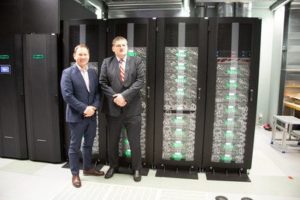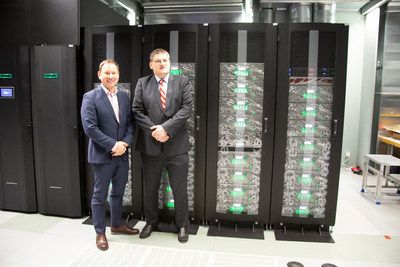 Today DDN announced that HLRS in Germany has selected DDN’s EXAScaler with IME scale-out flash storage system for “Hawk,” its new flagship supercomputer system, to support data-intensive workflows that combine big data analysis, deep learning and simulation, empowering scientists and engineers to conduct research on larger and more complex phenomena.
Today DDN announced that HLRS in Germany has selected DDN’s EXAScaler with IME scale-out flash storage system for “Hawk,” its new flagship supercomputer system, to support data-intensive workflows that combine big data analysis, deep learning and simulation, empowering scientists and engineers to conduct research on larger and more complex phenomena.
Hawk’s inauguration expands HLRS’s already excellent infrastructure and marks the beginning of a new era for research in areas that we previously have not been able to embark on,” said HLRS Director Michael Resch. “Using the power of computational science and engineering, Hawk will enable cutting-edge academic and industrial research, from complex tectonic interaction to weather patterns, to all be explored. Without the collaboration of our technology partners, such as DDN, a system of this caliber would have never been possible.”
With a peak performance (approximately 26 petaflops) that is 3.5 times faster than HLRS’s previous flagship computing system, Hawk is expected to be in the top 10 of the fastest supercomputers worldwide and the fastest general-purpose system in Europe. An inauguration ceremony was held for Hawk on Wed., Feb. 19 in Stuttgart as a celebration took place for the system’s future endeavors, including enabling new understanding for optimizing energy efficiency in wind turbines, optimizing motors and power plants, and improving aerodynamic performance in aircraft and automobile engineering. Utilizing DDN’s EXAScaler with IME solution to solve I/O scale and bottleneck challenges, more comprehensive and data-intensive simulations related to pandemic research, the prediction of migration flows and other global challenges will also become possible with Hawk.
For over 20 years, DDN’s focus has been on enabling at-scale data and to deliver solutions like IME with EXAScaler to help data-intensive organizations and research facilities break free from the challenges and inefficiencies caused by I/O bottlenecks,” said Robert Triendl, head of global sales at DDN. “DDN is honoured to collaborate with HLRS to provide computational and storage capabilities that help generate new discoveries, advance scientific understanding and allow scientists and engineers to take on grand challenges that have previously been unreachable or even unimaginable, in order to help us better understand the world around us.”
Configuration Details:
- 25PB Capacity
- 2x ES18K EXAScaler Appliance
- 32x 9012 Enclousers with 2400x 14TB Drives
- 1x SFA200NV with 11x 1.92TB
- 21x IME140X Appliances each with 9x 4TB NVME Drives
About the High-Performance Computing Center Stuttgart (HLRS)
The High-Performance Computing Center Stuttgart was established in 1996 as the first German national high-performance computing center, building on a tradition of supercomputing at the University of Stuttgart that stretches back to 1959. As a research institution affiliated with the University of Stuttgart and a founding member of the Gauss Centre for Supercomputing — the alliance of Germany’s three national supercomputing centers — HLRS provides state-of-the-art HPC services to academic users and industry. HLRS operates one of Europe’s most powerful supercomputers, provides advanced training in HPC programming and simulation, and conducts research to address key problems facing the future of supercomputing. Among HLRS’s areas of expertise are parallel programming, numerical methods for HPC, visualization, grid and cloud computing concepts, data analytics, and artificial intelligence. Users of HLRS computing systems are active across a wide range of disciplines, with an emphasis on computational engineering and applied science.




